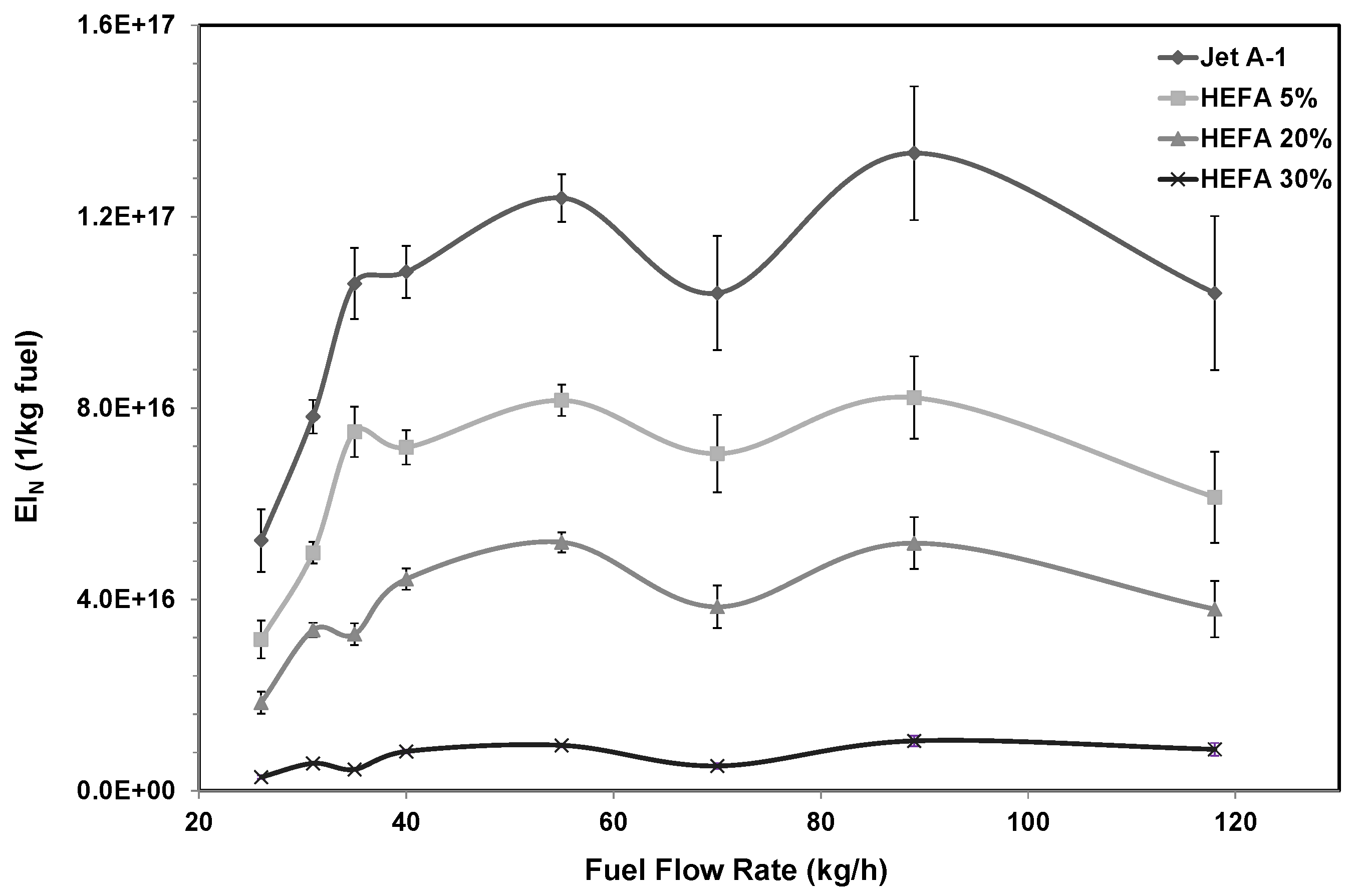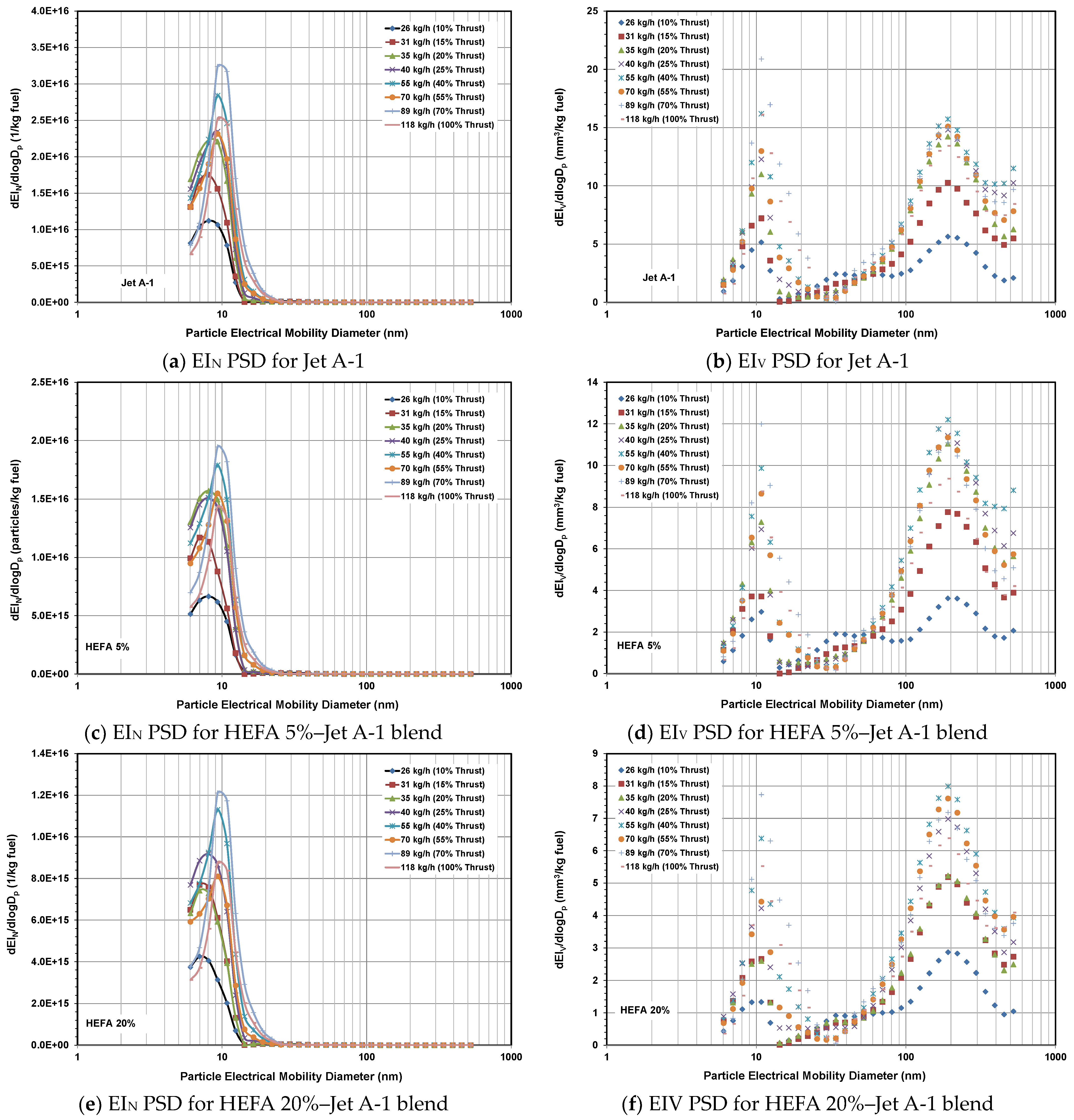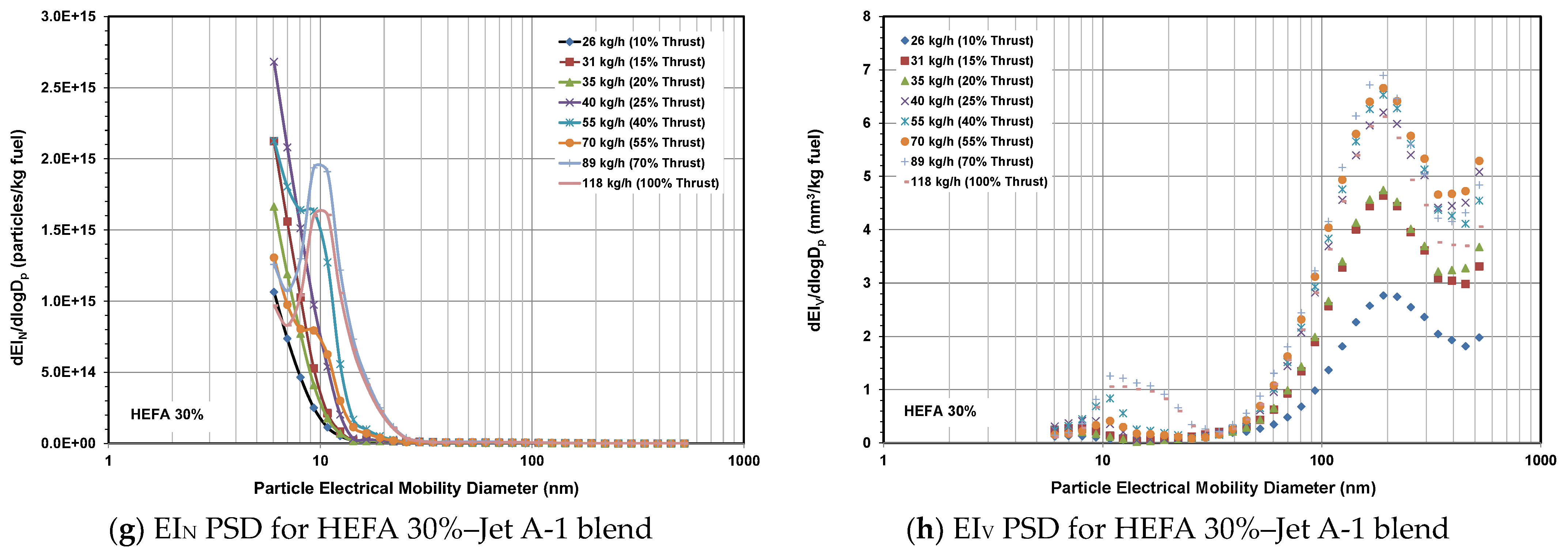Evaluating the Impact of Using HEFA Fuel on the Particulate Matter Emissions from a Turbine Engine
Abstract
:1. Introduction
2. Materials and Methods
2.1. Fuels, Test Engine, and Operating Schedule
2.2. Apparatus and Procedures
2.3. Data Analyses
3. Results
3.1. Particle Number and Mass Emission Indices
3.2. Particle Size Distribution
4. Discussion
5. Conclusions
- HEFA fuel significantly reduced particle emissions from the jet engine; a 5% share of SAF in a blend with aviation kerosene yielded distinct positive effects on both the number and mass of particles.
- Future research directions should focus on exploring the relationships between physicochemical parameters and exhaust emission. This exploration can facilitate the optimization of SAF production with a focus on minimizing exhaust emissions.
- The empirical data collected during SAF experiments can be utilized to develop analytical models for estimating the volatile fraction of particulate matter emissions.
Author Contributions
Funding
Data Availability Statement
Acknowledgments
Conflicts of Interest
References
- Reducing Emissions from Aviation. Available online: https://climate.ec.europa.eu/eu-action/transport/reducing-emissions-aviation_en (accessed on 7 December 2023).
- Pawlak, M.; Kuźniar, M. The Effects of the Use of Algae and Jatropha Biofuels on Aircraft Engine Exhaust Emissions in Cruise Phase. Sustainability 2022, 14, 6488. [Google Scholar] [CrossRef]
- Oliveira, J.; Brojo, F. Simulation of the combustion of bio-derived fuels in a CFM56-3 combustor. In Proceedings of the 2017 2nd International Conference Sustainable and Renewable Energy Engineering (ICSREE), Hiroshima, Japan, 10–12 May 2017; pp. 14–18. [Google Scholar] [CrossRef]
- Jasiński, R.; Kurzawska, P.; Przysowa, R. Characterization of Particle Emissions from a DGEN 380 Small Turbofan Fueled with ATJ Blends. Energies 2021, 14, 3368. [Google Scholar] [CrossRef]
- Ni, N.; Yuan, H.; Zhang, Z.; Bai, Y.; Zhu, M. Theoretical research on ship desulfurization wastewater freezing desalination system driven by waste heat. Desalination 2023, 549, 116363. [Google Scholar] [CrossRef]
- Lobo, P.; Condevaux, J.; Yu, Z.; Kuhlmann, J.; Hagen, D.E.; Miake-Lye, R.C.; Whitefield, P.D.; Raper, D.W. Demonstration of a Regulatory Method for Aircraft Engine Nonvolatile PM Emissions Measurements with Conventional and Isoparaffinic Kerosene fuels. Energy Fuels 2016, 30, 7770–7777. [Google Scholar] [CrossRef]
- Lobo, P.; Durdina, L.; Smallwood, G.J.; Rindlisbacher, T.; Siegerist, F.; Black, E.A.; Yu, Z.; Mensah, A.A.; Hagen, D.E.; Miake-Lye, R.C.; et al. Measurement of Aircraft Engine Non-Volatile PM Emissions: Results of the Aviation-Particle Regulatory Instrumentation Demonstration Experiment (A-PRIDE) 4 Campaign. Aerosol Sci. Technol. 2015, 49, 472–484. [Google Scholar] [CrossRef]
- Lobo, P.; Durdina, L.; Brem, B.T.; Crayford, A.P.; Johnson, M.P.; Smallwood, G.J.; Siegerist, F.; Williams, P.I.; Black, E.A.; Llamedo, A.; et al. Comparison of standardized sampling and measurement reference systems for aircraft engine non-volatile particulate matter emissions. J. Aerosol Sci. 2020, 145, 105557. [Google Scholar] [CrossRef]
- Petzold, A.; Marsh, R.; Johnson, M.; Miller, M.; Sevcenco, Y.; Delhaye, D.; Ibrahim, A.; Williams, P.; Bauer, H.; Crayford, A.; et al. Evaluation of Methods for Measuring Particulate Matter Emissions from Gas Turbines. Environ. Sci. Technol. 2011, 45, 3562–3568. [Google Scholar] [CrossRef]
- Durdina, L.; Brem, B.T.; Elser, M.; Schönenberger, D.; Siegerist, F.; Anet, J.G. Reduction of Nonvolatile Particulate Matter Emissions of a Commercial Turbofan Engine at the Ground Level from the Use of a Sustainable Aviation Fuel Blend. Environ. Sci. Technol. 2021, 55, 14576–14585. [Google Scholar] [CrossRef] [PubMed]
- ReFuelEU Aviation Initiative: Sustainable Aviation Fuels and the ‘Fit for 55’ Package. Available online: https://www.europarl.europa.eu (accessed on 12 May 2023).
- Gawron, B.; Białecki, T. Impact of a Jet A-1/HEFA blend on the performance and emission characteristics of a miniature turbojet engine. Int. J. Environ. Sci. Technol. 2018, 15, 1501–1508. [Google Scholar] [CrossRef]
- Gawron, B.; Białecki, T.; Janicka, A.; Suchocki, T. Combustion and Emissions Characteristics of the Turbine Engine Fueled with HEFA Blends from Different Feedstocks. Energies 2020, 13, 1277. [Google Scholar] [CrossRef]
- Przysowa, R.; Gawron, B.; Białecki, T.; Łęgowik, A.; Merkisz, J.; Jasiński, R. Performance and Emissions of a Microturbine and Turbofan Powered by Alternative Fuels. Aerospace 2021, 8, 25. [Google Scholar] [CrossRef]
- Fleuti, E. Airport air quality. Air Space Eur. 2001, 3, 43–44. [Google Scholar] [CrossRef]
- Moore, R.H.; Shook, M.A.; Ziemba, L.D.; DiGangi, J.P.; Winstead, E.L.; Rauch, B.; Jurkat, T.; Thornhill, K.L.; Crosbie, E.C.; Robinson, C.; et al. Take-off engine particle emission indices for in-service aircraft at Los Angeles International Airport. Sci. Data 2017, 4, 170198. [Google Scholar] [CrossRef] [PubMed]
- Ren, J.; Cao, X.; Liu, J. Impact of atmospheric particulate matter pollutants to IAQ of airport terminal buildings: A first field study at Tianjin Airport, China. Atmos. Environ. 2018, 179, 222–226. [Google Scholar] [CrossRef]
- Jasiński, R. Number and mass analysis of particles emitted by aircraft engine. In Proceedings of the MATEC Web of Conferences, Seoul, Republic of Korea, 22–25 August 2017; Volume 118, p. 00023. [Google Scholar] [CrossRef]
- Kurzawska, P.; Jasiński, R. Overview of Sustainable Aviation Fuels with Emission Characteristic and Particles Emission of the Turbine Engine Fueled ATJ Blends with Different Percentages of ATJ Fuel. Energies 2021, 14, 1858. [Google Scholar] [CrossRef]
- Cabrera, E.; de Sousa, J.M.M. Use of Sustainable Fuels in Aviation—A Review. Energies 2022, 15, 2440. [Google Scholar] [CrossRef]
- Chiaramonti, D. Sustainable Aviation Fuels: The challenge of decarbonization. Energy Procedia 2019, 158, 1202–1207. [Google Scholar] [CrossRef]
- Pawlak, M.; Majka, A.; Kuzniar, M.; Pawluczy, J. Model of Emission of Exhaust Compounds of Jet Aircraft in Cruise Phase Enabling Trajectory Optimization. Transport 2020, 35, 87–97. [Google Scholar] [CrossRef]
- Pawlak, M.; Kuźniar, M. Determination of CO2 Emissions for Selected Flight Parameters of a Business Jet Aircraft. J. KONES 2019, 26, 155–163. [Google Scholar] [CrossRef]
- DGEN 380 BR Training (Unpublished), Price Induction; Aviation Pros: Atlanta, GA, USA, 2017.
- Durdina, L.; Brem, B.T.; Abegglen, M.; Lobo, P.; Rindlisbacher, T.; Thomson, K.A.; Smallwood, G.J.; Hagen, D.E.; Sierau, B.; Wang, J. Determination of PM mass emissions from an aircraft turbine engine using particle effective density. Atmos. Environ. 2014, 99, 500–507. [Google Scholar] [CrossRef]
- Okai, K.; Fujiwara, H.; Makida, M.; Shimodaira, K. The effect of the fuel change from petroleum kerosene to HEFA alternative jet fuel on the number of nvPM emission of an RQL gas turbine combustor. In Proceedings of the AIAA Scitech 2019 Forum, San Diego, CA, USA, 7–11 January 2019. [Google Scholar] [CrossRef]
- Sundararaj, R.H.; Kumar, R.D.; Raut, A.K.; Sekar, T.C.; Pandey, V.; Kushari, A.; Puri, S.K. Combustion and emission characteristics from biojet fuel blends in a gas turbine combustor. Energy 2019, 182, 689–705. [Google Scholar] [CrossRef]
- Xue, X.; Hui, X.; Singh, P.; Sung, C.-J. Soot formation in non-premixed counterflow flames of conventional and alternative jet fuels. Fuel 2017, 210, 343–351. [Google Scholar] [CrossRef]
- Schripp, T.; Anderson, B.; Crosbie, E.C.; Moore, R.H.; Herrmann, F.; Oßwald, P.; Wahl, C.; Kapernaum, M.; Köhler, M.; le Clercq, P.; et al. Impact of Alternative Jet Fuels on Engine Exhaust Composition during the 2015 ECLIF Ground-Based Measurements Campaign. Environ. Sci. Technol. 2018, 52, 4969–4978. [Google Scholar] [CrossRef] [PubMed]
- Rojo, C.; Vancassel, X.; Mirabel, P.; Ponche, J.-L.; Garnier, F. Impact of alternative jet fuels on aircraft-induced aerosols. Fuel 2015, 144, 335–341. [Google Scholar] [CrossRef]
- Tran, S.; Brown, A.; Olfert, J.S. Comparison of Particle Number Emissions from In-Flight Aircraft Fueled with Jet A1, JP-5 and an Alcohol-to-Jet Fuel Blend. Energy Fuels 2020, 34, 7218–7222. [Google Scholar] [CrossRef]
- Lobo, P.; Hagen, D.E.; Whitefield, P.D. Comparison of PM Emissions from a Commercial Jet Engine Burning Conventional, Biomass, and Fischer–Tropsch Fuels. Environ. Sci. Technol. 2011, 45, 10744–10749. [Google Scholar] [CrossRef]
- Chan, T.W.; Canteenwalla, P.; Chishty, W.A. Characterization of Fuel Composition and Altitude Impact on Gaseous and Particle Emissions from a Turbojet Engine. In Volume 4A: Combustion, Fuels and Emissions; American Society of Mechanical Engineers: New York, NY, USA, 2017. [Google Scholar] [CrossRef]
- Kinsey, J.S.; Squier, W.; Timko, M.; Dong, Y.; Logan, R. Characterization of the Fine Particle Emissions from the Use of Two Fischer–Tropsch Fuels in a CFM56-2C1 Commercial Aircraft Engine. Energy Fuels 2019, 33, 8821–8834. [Google Scholar] [CrossRef]
- Wayson, R.L.; Fleming, G.G.; Iovinelli, R. Methodology to Estimate Particulate Matter Emissions from Certified Commercial Aircraft Engines. J. Air Waste Manag. Assoc. 2009, 59, 91–100. [Google Scholar] [CrossRef]




| Parameter | Value |
|---|---|
| Maximum thrust | 255 daN |
| Specific fuel consumption (for maximum thrust) | 12.4 g/kN·s |
| Bypass ratio | 7.6 |
| Weight | 85 kg |
| Lifetime | 3600 h |
| Fuel Type | Average Sample Gas Temperature (°C) ± 0.1 | Fuel Flow Rate (kg/h) ± 1.5 kg | Tested Percent Rated Thrust Settings (%) ± 2% Value |
|---|---|---|---|
| Jet A-1 | 15.4 | 26, 31, 35, 40, 55, 70, 89, 118 | 10, 13, 20, 26, 40, 56, 72, 97 |
| HEFA 5% | 15.8 | 26, 31, 35, 40, 55, 70, 89, 118 | 10, 13, 20, 26, 40, 56, 72, 97 |
| HEFA 20% | 16.0 | 26, 31, 35, 40, 55, 70, 89, 118 | 10, 13, 20, 26, 40, 56, 72, 97 |
| HEFA 20% | 15.8 | 26, 31, 35, 40, 55, 70, 89, 118 | 10, 13, 20, 26, 40, 56, 72, 97 |
| HEFA 30% | 15.9 | 26, 31, 35, 40, 55, 70, 89, 118 | 10, 13, 20, 26, 40, 56, 72, 97 |
| HEFA 30% | 16.0 | 26, 31, 35, 40, 55, 70, 89, 118 | 10, 13, 20, 26, 40, 56, 72, 97 |
| Fuel Type | Thrust (%) | Median | |||||||
|---|---|---|---|---|---|---|---|---|---|
| 10 | 15 | 20 | 25 | 40 | 55 | 70 | 100 | ||
| HEFA 5% | −0.396 | −0.364 | −0.292 | −0.338 | −0.341 | −0.322 | −0.384 | −0.410 | −0.352 |
| HEFA 20% | −0.648 | −0.570 | −0.691 | −0.592 | −0.581 | −0.630 | −0.612 | −0.635 | −0.621 |
| HEFA 30% | −0.946 | −0.927 | −0.958 | −0.924 | −0.923 | −0.950 | −0.922 | −0.917 | −0.926 |
| Fuel Type | Thrust (%) | Median | |||||||
|---|---|---|---|---|---|---|---|---|---|
| 10 | 15 | 20 | 25 | 40 | 55 | 70 | 100 | ||
| HEFA 5% | −0.323 | −0.306 | −0.249 | −0.312 | −0.300 | −0.283 | −0.391 | −0.417 | −0.309 |
| HEFA 20% | −0.602 | −0.540 | −0.651 | −0.576 | −0.544 | −0.569 | −0.585 | −0.596 | −0.580 |
| HEFA 30% | −0.775 | −0.727 | −0.795 | −0.741 | −0.763 | −0.731 | −0.767 | −0.750 | −0.757 |
Disclaimer/Publisher’s Note: The statements, opinions and data contained in all publications are solely those of the individual author(s) and contributor(s) and not of MDPI and/or the editor(s). MDPI and/or the editor(s) disclaim responsibility for any injury to people or property resulting from any ideas, methods, instructions or products referred to in the content. |
© 2024 by the authors. Licensee MDPI, Basel, Switzerland. This article is an open access article distributed under the terms and conditions of the Creative Commons Attribution (CC BY) license (https://creativecommons.org/licenses/by/4.0/).
Share and Cite
Jasiński, R.; Przysowa, R. Evaluating the Impact of Using HEFA Fuel on the Particulate Matter Emissions from a Turbine Engine. Energies 2024, 17, 1077. https://doi.org/10.3390/en17051077
Jasiński R, Przysowa R. Evaluating the Impact of Using HEFA Fuel on the Particulate Matter Emissions from a Turbine Engine. Energies. 2024; 17(5):1077. https://doi.org/10.3390/en17051077
Chicago/Turabian StyleJasiński, Remigiusz, and Radosław Przysowa. 2024. "Evaluating the Impact of Using HEFA Fuel on the Particulate Matter Emissions from a Turbine Engine" Energies 17, no. 5: 1077. https://doi.org/10.3390/en17051077






